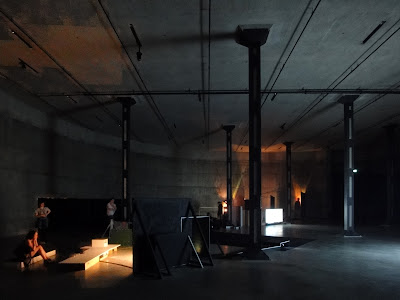The Tanks at Tate Modern in London opened to the public last month. Three old oil tanks of the former power station have been transformed into new spaces dedicated to installation, video, and performance pieces. These concrete cylinders are not visible from the outside, accessed only via underground connection from the Turbine Hall.
It’s pretty dark inside. You feel an atmosphere unlike a white cube gallery, nor a black box theater. It’s more like a secret dungeon where any crazy sh*t can happen – a perfect cool place for experimental art. I am not sure about the choice of Sung Hwan Kim, who has divided one tank into rooms for different videos. But the other tank that is left empty for performance programs reveals the full dimension: 30 meters in diameter and 7 meters in height.
 |
| Remember that joke about revision clouds? |
The Tanks are the first stage of the Tate Modern extension project by Herzog & de Meuron. Here, the architects’ intervention is quite subtle. Instead of fixing it up to a posh gallery with white walls and wooden floors, they decided to just leave it in its raw industrial status with rough concrete texture. They also let the massive voids speak for themselves – there’s no need to dramatize what’s already impressive.
In an interview with Sonntags Zeitung, Jacques Herzog said, “We have avoided the dialectics of old and new, as preferred by many architects from Modernism up to today.” This is an important conceptual shift. It’s so easy to put a sleek glass skylight or entrance and make it a distinct feature in the new romantic galleries. But HdM resisted the temptation. They chose to think about what was already there before forcing anything new. This approach matches the philosophy behind their Serpentine pavilion this year, just in this case they work with more physical existence, not only ghosts. They have cleaned the dirty parts, patched up the damaged parts, and the only new element is probably the diagonal concrete columns that support the extended galleries above. The result is a continuation, or even reinforcement of history; a composition of the present and the past, where the junction of the two become blurry and uncertain.
Outside in the Turbine Hall, Tino Sehgal is the star of this year’s edition of Unilever Series. The massive Turbine Hall is turned into a stage for Sehgal’s crew, who are walking, running, humming, chanting, singing, and telling stories all over the place. Lighting in the space has also been coordinated with the loosely choreographed performance. This simple but brilliant live piece brings in very special energies, interacting closely with the visitors. Strangely, it reminds me of the Occupy movement. It also reminds me that happiness does not necessarily rely on materialism. I am glad to see the intangible form of art, as the Tanks are promoting, has gained more recognition in the recent years.





















No comments:
Post a Comment